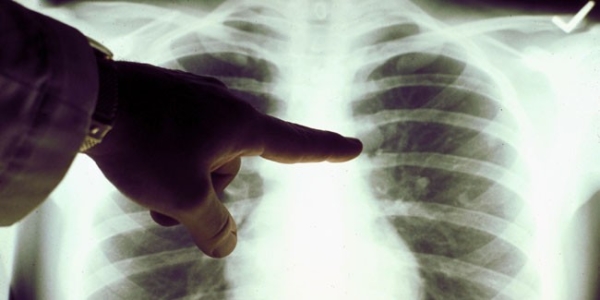
One of the most well-known and significant risks of smoking is that of lung cancer. The fact that e-cigarettes offer nicotine without the vast quantities of cancer-causing chemicals you’d find in a tobacco cigarette is one of the main reasons smokers choose to make the switch in the first place.
However, a new pre-clinical study presented at a conference last month has called this theory into question, suggesting that human lung cells with mutations associated with a high cancer risk exhibit more “cancerous behaviors” after being exposed to e-cigarette vapor.
The details of the research need to be filled in, but the potential of the finding is so surprising that it warrants further investigation.
The Study – Exposing Mutated Cells to Smoke and E-Cig Vapor
Firstly, it must be stressed that this was a pre-clinical study, effectively a first-line of research which is used to determine whether a relationship exists and therefore if it warrants further investigation.
 In this study, the researchers investigated the effect of e-cigarette vapor and cigarette smoke on cultured lung cells bearing mutations in the P53 and KRAS genes. According to lead author Stacy J. Park, Ph.D., “Mutations in the genes P53 and KRAS are often found in the airways of current and former smokers at high risk for lung cancer.” The cells were grown in a liquid medium which had been exposed to either electronic cigarette vapor or tobacco smoke for four hours.
In this study, the researchers investigated the effect of e-cigarette vapor and cigarette smoke on cultured lung cells bearing mutations in the P53 and KRAS genes. According to lead author Stacy J. Park, Ph.D., “Mutations in the genes P53 and KRAS are often found in the airways of current and former smokers at high risk for lung cancer.” The cells were grown in a liquid medium which had been exposed to either electronic cigarette vapor or tobacco smoke for four hours.
According to the published abstract of the study (aside from news reporting, the only information available on the research), the cells were either exposed to e-cig vapor with a low nicotine concentration chosen to replicate the amounts found in the blood of vapers or a higher concentration. This higher concentration was chosen as an estimate of the nicotine levels the cells would be exposed to in real-world usage, although this concentration is not revealed in the abstract. Additionally, some cells were exposed to tobacco smoke and some were left untreated to enable comparison.
 With regards to the results, Park commented, “We found that e-cigarette exposure enhances the aggressive behavior of human lung epithelial cells that have P53 and KRAS mutations. As a result, we think that e-cigarette exposure could contribute to lung cancer in individuals at high risk for the disease. Clearly, our results are very preliminary, and much more research is needed to better establish the role of e-cigarettes in lung cancer. But I think they show that people should approach e-cigarette use with caution and not assume it is safe.”
With regards to the results, Park commented, “We found that e-cigarette exposure enhances the aggressive behavior of human lung epithelial cells that have P53 and KRAS mutations. As a result, we think that e-cigarette exposure could contribute to lung cancer in individuals at high risk for the disease. Clearly, our results are very preliminary, and much more research is needed to better establish the role of e-cigarettes in lung cancer. But I think they show that people should approach e-cigarette use with caution and not assume it is safe.”
Reporting from sites such as MedicalXpress explains that the cells exhibited cancer-like behaviors in both the e-cigarette vapor and tobacco smoke conditions. These included things like colony formation, which is an integral process for the survival and the spreading of cancer. There were also changes in gene expression similar to those seen in the tobacco smoke medium.
So, E-Cigs Promote Lung Cancer, Right?
There are some important extra pieces of information added by the abstract which didn’t make it into the press reporting.
Firstly, the abstract explains that invasive behaviors occurred in the mutated genes at baseline (with no tobacco smoke or e-cig vapor) due to the specific mutations chosen. KRAS gene mutations are known risk factors for cancer, but not thought to be a direct cause, according to the National Institutes of Health’s Genetics Home Reference site. The P53 protein is a tumor suppressor, which basically means that it inhibits the growth of cancers. In this research, it was “silenced,” so it doesn’t seem too surprising that invasive behaviors occurred even in the absence of smoke or vapor. The abstract also suggests that colony growth occurred in the untreated sample, by saying that the high-nicotine sample “enhanced colony growth […] compared to the untreated and low nicotine treatment groups.”
The MIT website has some useful information about the impact of both of these mutations when used in mouse models of cancer, “Combining mutations in K-ras and p53 in the lung led to the development of more advanced tumors, which exhibited desmoplastic stroma, increased invasiveness and metastatic potential.” In other words, the mutations chosen tend to produce aggressive cancers with high potential to spread.
Research into snus (which contain the same trace carcinogens as e-cigs in larger quantities) has shown that P53 mutations are not common in users, so it seems reasonable to assume that these wouldn't be common in vapers either.
Additionally, the results in the abstract make it clear that the low and high nicotine conditions did not have the same impact. The lower nicotine concentration (the one based on actual plasma nicotine levels in vapers) wasn’t toxic to the cells, and it didn’t promote additional growth of colonies. The high-nicotine (at an unstated concentration) and tobacco smoke did enhance colony growth, after the cells were exposed to the medium for 10 days. Similarly, with the findings related to changes in gene expression, it was the high nicotine condition which produced cigarette-like changes, and this occurred after 96 hours of exposure.
Conclusion – Lots of Questions, Too Few Answers
Sadly, e-cig researchers such as Dr. Farsalinos and Dr. Siegel have not yet addressed the research in their always illuminating blog posts which delve deeper into findings like this. As non-geneticists, non-doctors and non-experts, we join Steve K. in anxiously awaiting one of them to provide some informed analysis on this research. Even to a layman, however, it’s clear that there is much more to this story than “e-cigs promote lung cancer in those at-risk.”
With an unclear nicotine content in the tests producing headline-friendly, tobacco-like results, the seemingly long periods of exposure and the apparently expected cancer-like behavior from the combination of mutations, there is clearly more information that needs to be provided in order to comprehend the significance of these findings, and we haven’t yet been deemed worthy of finding it out through news reporting.
E-cigarettes do need to be researched further, but it doesn’t escape notice that any claim of significant harm from them is riddled with anything from uncertainty – as is abundant in this case – to outright misappropriation of findings. Whether this study will require down-grading to the ranks of “misleading nonsense” is yet to be seen.
Articles related to “e-cig vapor”
- Study: Is Second-Hand E-Cigarette Vapor Dangerous? A new piece of research has investigated the concentrations of nicotine, carbon monoxide and various volatile organic compounds after e-cigarette use, and compared them to those from a traditional cigarette.
- Study: Most E-Cig Vapor Poses No Risk to Heart Cells A new piece of research from Dr. Farsalinos and his colleagues has investigated the potential cytotoxicity of e-cig vapor, and found that the vast majority of vaporized liquids are much safer than the smoke from traditional cigarettes.
- Review of Existing Evidence Confirms No Risk From E-Cig Vapor A new study, funded by CASAA, has looked at the existing data on the contents of e-liquids and the vapor from e-cigs, and found no evidence of risk to vapers, even under “worst case” scenarios.
- Typical Vapor Content of an E-Cigarette For the most part, we know exactly what goes into the production of the liquid used in the majority of electronic cigarettes. E-liquid typically consists of four main ingredients: propylene glycol, vegetable glycerin, nicotine and flavoring. What isn’t exactly clear is what constituents make up the vapor e-cigarettes produce.
Photo Credit: Liberty Voice (guardianlv.com)

